1993 CHEVROLET CAMARO tire pressure
[x] Cancel search: tire pressurePage 148 of 358
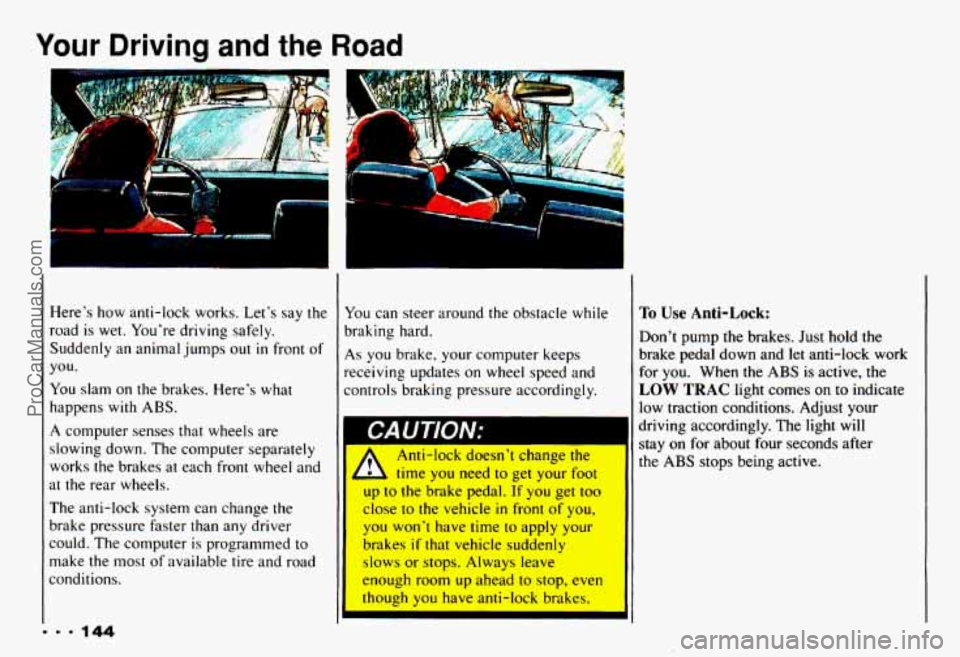
Your Driving and the Road
I
Here's how anti-lock works. Let's say the
road is wet. You're driving safely.
Suddenly an animal jumps out
in front of
you.
You slam on
the brakes. Here's what
happens with ABS.
A computer senses that wheels are
slowing down. The computer separately
works the brakes at each front wheel and
at the rear wheels.
The anti-lock system can change
the
brake pressure faster than any driver
could. The computer is programmed
to
make the most of available tire and road
conditions.
1
You can steer around the obstacle while
braking hard.
As you brake, your conlputer keeps
receiving updates
on wheel speed and
controls braking pressure accordingly.
I CAUTION;
A
Anti-lock doesn't change the
time
you need to get your foot
up
to the brake pedal. If you get too
close
to the vehicle in front of you,
1 you won't have time to apply your
brakes
if that vehicle suddenly
slows or stops. Always leave
enough room up ahead
to stop, even
though
you have anti-lock brakes.
I'o Use Anti-Lock:
Don't pump the brakes. Just hold the
brake pedal down and
let anti-lock work
for you. When the
ABS is active, the
LOW TRAC light comes on to indicate
low traction conditions. Adjust your
driving accordingly. The light will
stay on for about four seconds after
the
ABS stops being active.
ProCarManuals.com
Page 161 of 358
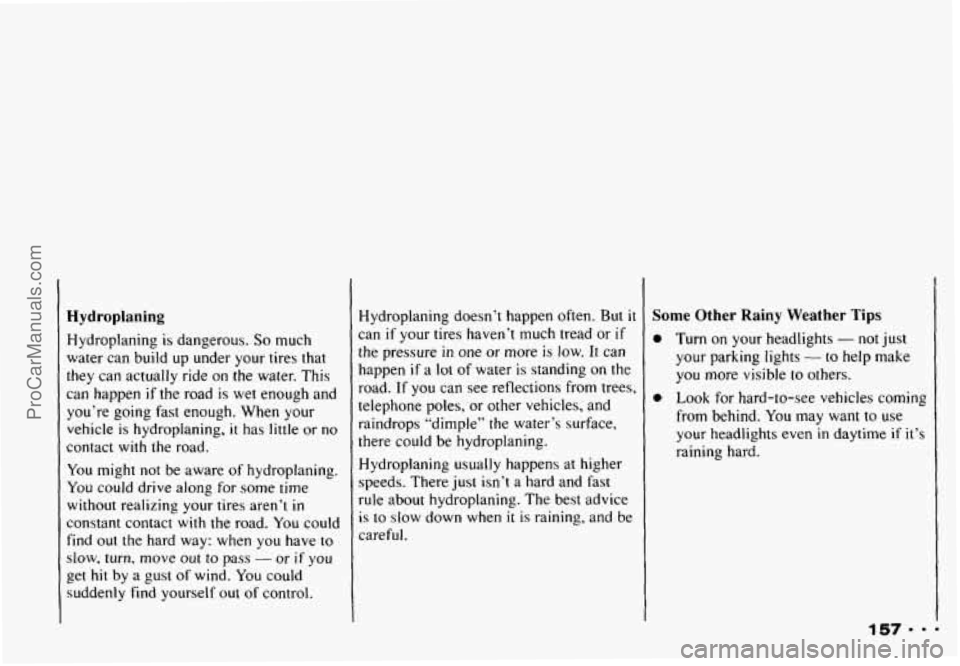
Hydroplaning
Hydroplaning is dangerous. So much
water can build up under your tires that
they can actually ride on the water. This
can happen
if the road is wet enough and
you’re going fast enough. When your
vehicle
is hydroplaning, it has little or no
contact
with the road.
You might not be aware of hydroplaning.
You could drive along for some time
without realizing your tires aren’t
in
constant contact with the road. You could
find
out the hard way: when you have to
slow, turn, move out to pass - or if you
get hit by a gust of wind. You could
suddenly find yourself out of control. Hydroplaning doesn’t happen
often.
But it
can if your tires haven’t much tread or if
the pressure in one or more is low. It can
happen
if a lot of water is standing on the
road.
If you can see reflections from trees,
telephone poles, or other vehicles, and
raindrops “dimple” the water’s surface,
there could be hydroplaning.
Hydroplaning usually happens at higher
speeds. There
just isn’t a hard and fast
rule about hydroplaning. The best advice
is to
slow down when it is raining, and be
careful.
Some Other Rainy Weather Tips
0
Turn on your headlights - not just
your parking lights
- to help make
you more visible to others.
Look for hard-to-see vehicles coming
from behind.
You may want to use
your headlights even
in daytime if it’s
raining hard.
ProCarManuals.com
Page 167 of 358

Driving a Long
Distance
Although most long trips today are made
on freeways, there are
still many made on
regular highways.
Long-distance driving on freeways and
regular highways
is the same in some
ways. The
trip has to be planned and the
vehicle prepared, you drive at
higher-than-city speeds, and there are
longer turns behind the wheel. You’ll
enjoy your trip more
if you and your
vehicle are
in good shape. Here are some
:ips for a successful long trip.
Before Leaving on a Long Trip
Make sure you’re ready. Try to be well
rested. If you must start when you’re not
fresh
- such as after a day’s work -
don’t plan to make too many miles that
first part of the journey. Wear comfortable
clothing and shoes you can easily drive
in.
Is your vehicle ready for a long trip? If
you keep
it serviced and maintained, it’s
ready to go. If
it needs service, have it
done before starting out. Of course, you’ll
find experienced and able service experts
in Chevrolet dealerships all across North
America. They’ll be ready and willing to
help
if you need it. Here
are some things you can check
before a trip:
0
0
0
0
0
Windshield Washer Fluid: Is the
reservoir
full? Are all windows clean
inside and outside?
Wiper Blades: Are they in good
shape?
Fuel, Engine Oil, Other Fluids:
Have you checked all levels?
Lights: Are they all working? Are the
lenses clean?
Tires: They are vitally important to a
safe, trouble-free trip.
Is the tread
good enough for long-distance
driving? Are the tires all inflated to
the recommended pressure?
163 -
ProCarManuals.com
Page 208 of 358
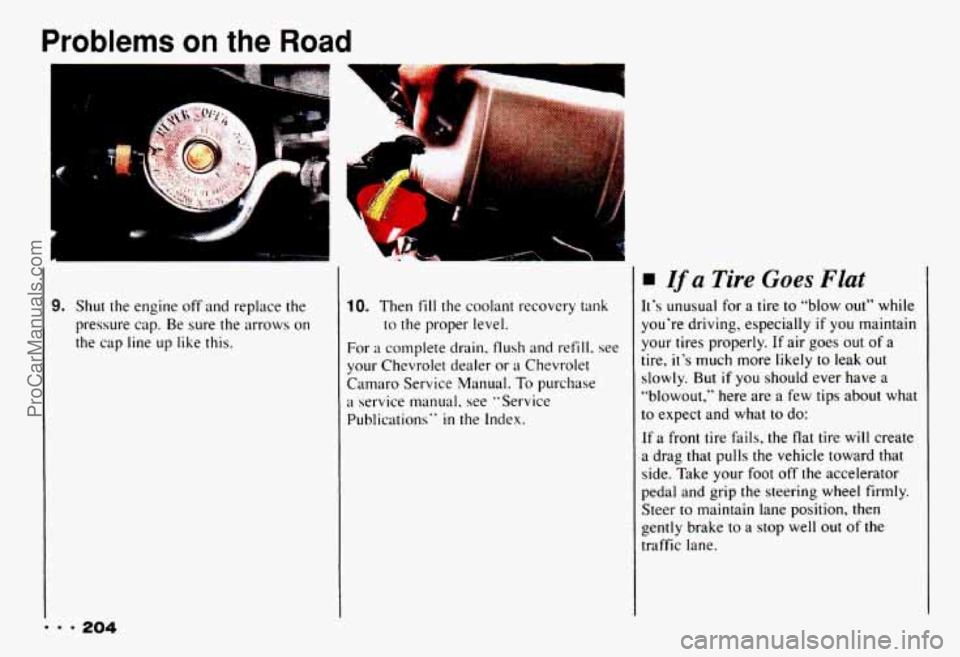
Problems on the Road
I lh
1
F. $. '
9. Shut the engine off and replace the
pressure cap. Be sure the arrows
on
the cap line up like this.
Y CI.
10. Then fill the coolant recovery tank
For a complete drain. flush and refill, see
your Chevrolet dealer or a Chevrolet
Carnaro Service
Manual. To purchase
a service manual, see "Service
Publications"
in the Index.
to the proper level.
If a Tire Goes Flat
It's unusual for
a tire to "blow out" while
you're driving, especially
if you maintain
your tires properly.
If air goes out of a
tire, it's much more likely
to leak out
slowly.
But if you should ever have a
"blowout," here are a few tips about what
to expect and what to do:
If a front tire fails, the flat tire will create
a drag that pulls the vehicle toward that
side. Take your foot off the accelerator
pedal and grip the steering wheel firmly.
Steer
to maintain lane position, then
gently brake to a stop well out of
the
traffic lane.
ProCarManuals.com
Page 218 of 358
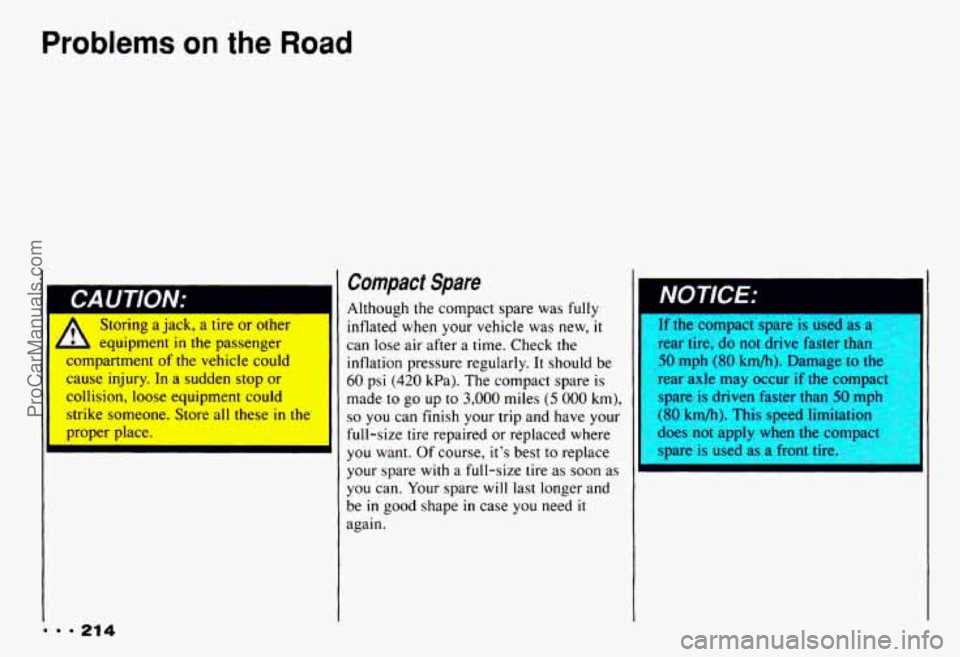
Problems on the Road
II , Storing aJacK, a tlre or otner I
4 equipment in the passenger
Ldmpartment of the vehicle could
cause injury. In a sudden
stop or
collision, loose equipment could
strike someone. Store all these
in the
proper place.
Compact Spare
Although the compact spare was fully
inflated when your vehicle was new, it
can lose air after a time. Check the
inflation pressure regularly.
It should be
60 psi (420 kPa). The compact spare is
made to go up to 3,000 miles (5 000 km),
so you can finish your trip and have your
full-size tire repaired or replaced where
you want. Of course,
it’s best to replace
your spare
with a full-size tire as soon as
you can. Your spare
will last longer and
be
in good shape in case you need it
again.
NOTICE:
lr tne compact spare 1s use0 as a
rear tire, do not drive faster than
50 mph (80 km/h). Damage to the
rear axle may occur
if the compac
snare
is driven faster than 50 mnh
( 0 km/h). This speed limitatia
does
not apply when the COI
ware is used as a front tire.
ProCarManuals.com
Page 252 of 358

Service & Appearance Care
Headlights
Headlight Aiming
Your vehicle has a mini-quad headlight
system. These headlights have vertical
and horizontal indicators. When the
headlights are properly installed and
adjusted, and the vehicle is on level
ground, both indicators will read in the
center of the gage. If they do not, you can
adjust the aim.
A
To adjust the aim of your headlights:
1. Move your vehicle to a level surface.
Use a spirit level to be sure. Be sure
to remove any items that are not part
of your original equipment from the
trunk and passenger areas.
No one
should be seated in the vehicle and
your fuel tank should be about half
full. Check to be sure your tires are
at the correct pressure. There
are four headlights. Each one
has its own vertical and horizontal
aim position indicator. Each indicator
has its own aiming screw.
A. Vertical Indicator
B. Horizontal Indicator
C. Vertical Aiming Screw
D. Horizontal Aiming Screw
ProCarManuals.com
Page 259 of 358
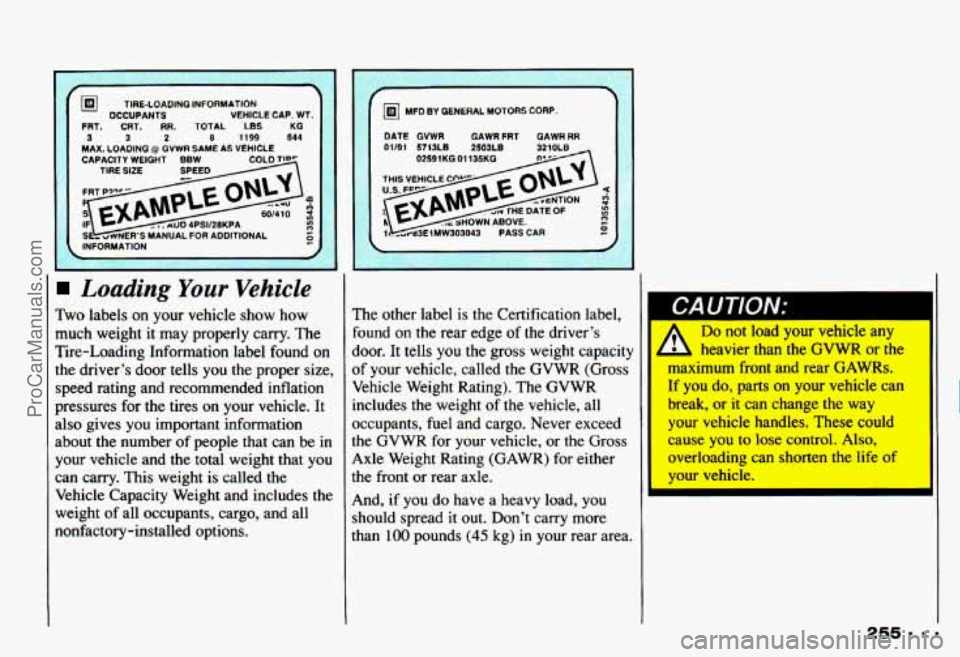
CAPACITY WEIGHT BBW TIRE SIZE
INFORMATION
Loading Your Vehicle
Two labels on your vehicle show how
much weight it may properly carry. The
Tire-Loading Information label found on
the driver’s door tells
you the proper size,
speed rating and recommended inflation
pressures for
the tires on your vehicle. It
also gives you important information
about the number of people that can be in
your vehicle and the total weight that
you
can carry. This weight is called the
Vehicle Capacity Weight and includes the
weight of all occupants, cargo, and all
nonfactory-installed options.
DATE GVWR GAWRFRT GAWR RR 01/91 5713LB ZS03LB <. .
v)
The other label is the Certification label,
found on
the rear edge of the driver’s
door. It tells you the gross weight capacity
of your vehicle, called the GVWR (Gross
Vehicle Weight Rating). The GVWR
includes the weight of the vehicle, all
occupants, fuel and cargo. Never exceed
the GVWR for your vehicle,
or the Gross
Axle Weight Rating (GAWR) for either
the front or rear axle.
And,
if you do have a heavy load, you
should spread it out. Don’t carry more
than
100 pounds (45 kg) in your rear area.
Do not load your vehicle any
- L heavier than the GVWR or the
maximum front and rear GAWRs.
If you do, parts on your vehicle can
break, or
it can change the way
your vehicle handles. These could
cause you to lose control.
Also,
overloading can shorten the life of , ,
II
ProCarManuals.com
Page 261 of 358
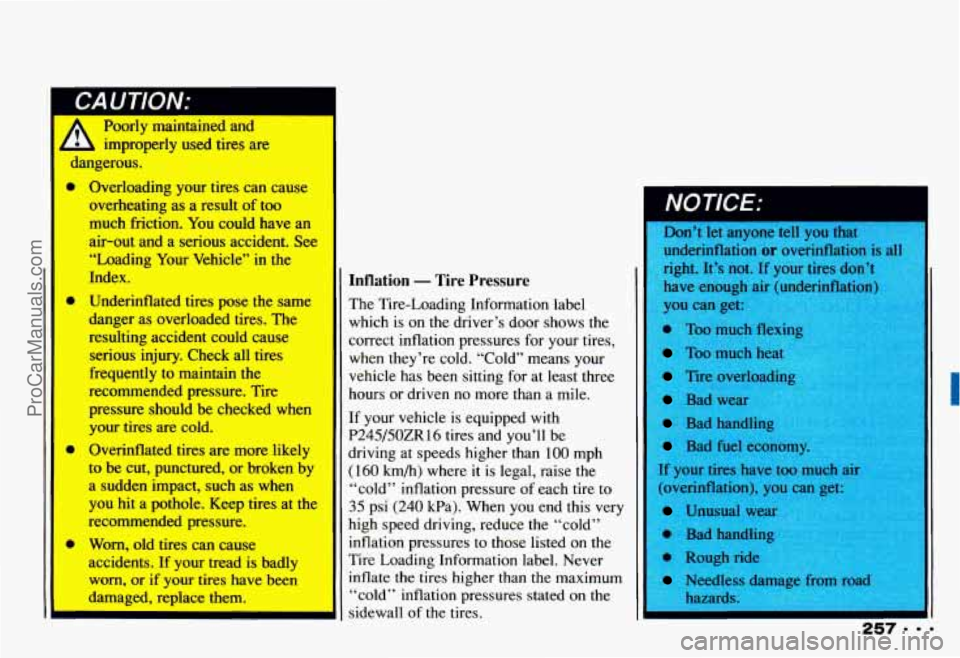
CAUTION:
Poorly maintained and
improperly used tires are
dangerous.
a
m
a
Overloading your tires can cause
overheating as
a result of too
much friction. You could have
an
air-out and a serious accident. See
“Loading Your Vehicle” in the
Index.
Underinflated tires pose the
same
danger as overloaded tires. The
resulting accident could cause
serious
injury. Check all tires
frequently to maintain the
recommended
pressure. Tire
pressure should
be checked when
your tires are cold.
Overinflated tires
are more likely
to be cut, punctured, or broken by
a sudden impact, such as when
you
hit a pothole. Keep tires at the
recommended pressure.
Worn, old tires can cause
accidents.
If your tread is badly
worn, or if your tires have been
damaged, replace them.
I
Inflation - Tire Pressure
The Tire-Loading Information label
which
is on the driver’s door shows the
correct inflation pressures for your tires,
when they’re cold. “Cold” means your
vehicle has been sitting for at least three
hours or driven no more than a mile.
If your vehicle is equipped
with
P245/50ZR16 tires and you’ll be
driving at speeds higher than
100 mph
(160 km/h) where it is legal, raise the
“cold” inflation pressure of each tire to
35 psi (240 kPa). When you end this very
high speed driving, reduce the “cold”
inflation pressures to those listed on the
Tire Loading Information label. Never
inflate the tires higher than the maximum
“cold” inflation pressures stated on the
sidewall of the tires. Don’t let anyone tell
you that
underinflation
or overinflation is all
right. It’s not.
If your tires don’t
haveenougha
n)
you can get
e Too muc
Too much heal
Tire overloading
Bad wear
Bad handli
Bad fuel econ
I If your tires have too much air
(overinflation), you
can get’
Unusual wear
’ 0 Bad handling
e Rough ri,,
Needless damage fi~111
hazards.
~
I
ProCarManuals.com